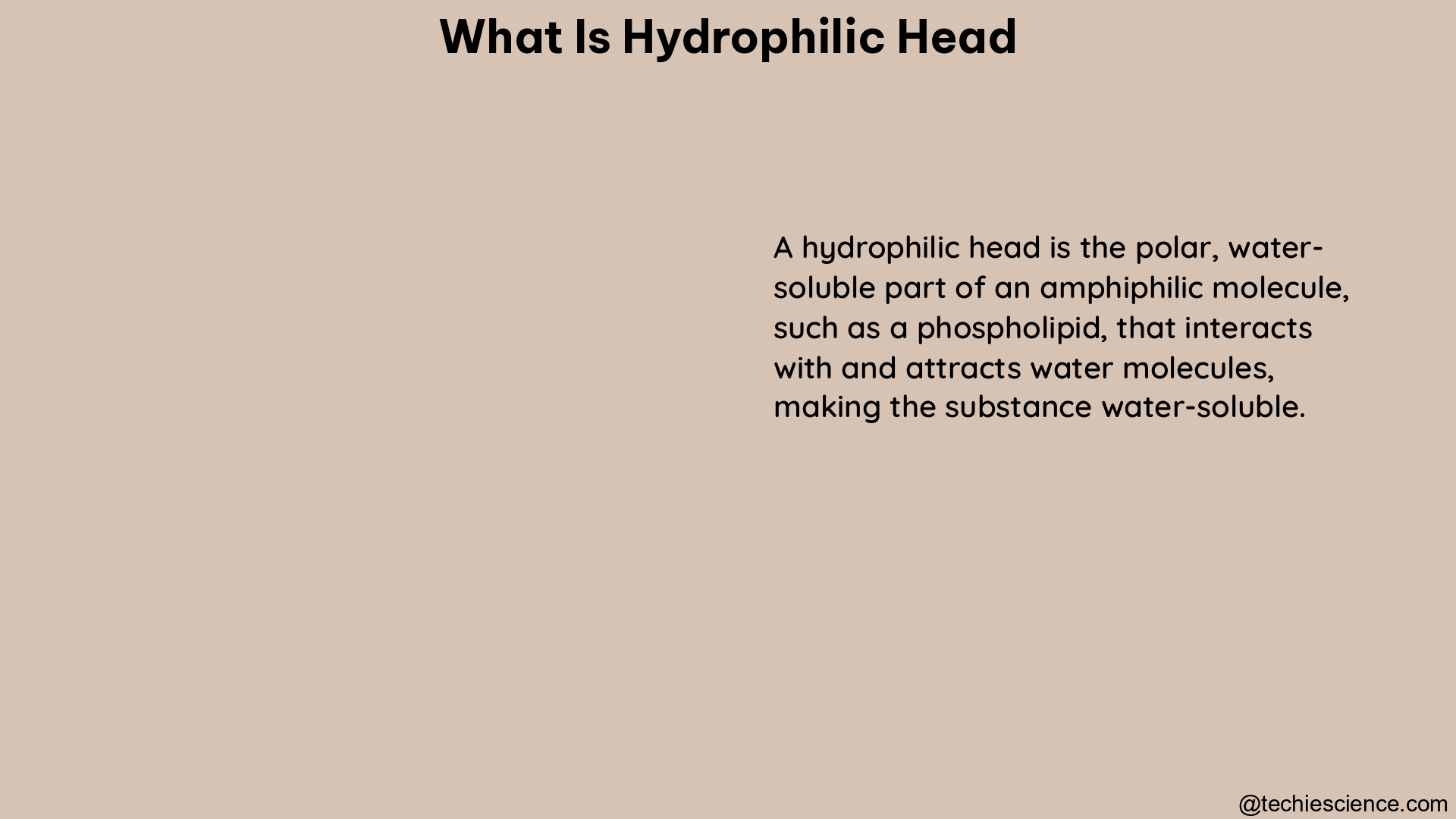The hydrophilic head of a phospholipid is a fundamental element that plays a pivotal role in the formation and function of biological membranes. It is composed of a phosphate group (PO4) and a glycerol molecule, which together create a highly polar region that is attracted to water molecules. This polar nature is attributed to the negative charge carried by the phosphate group, rendering the hydrophilic head “water-loving.”
Quantifiable Characteristics of the Hydrophilic Head
When it comes to the measurable and quantifiable aspects of the hydrophilic head, several key data points are worth considering:
-
Cross-Sectional Area: The cross-sectional area of each hydrophilic head within a lipid bilayer ranges between approximately ¼ and ½ nm (BNID 106993). This dimension is crucial for understanding the packing and geometry of phospholipids in biological membranes.
-
Length: The characteristic length of the hydrophilic head is approximately 2 nm (BNID 105298). This value provides insights into the overall structure and organization of the lipid bilayer.
-
Mass: The mass of each hydrophilic head typically falls within the range of 500-1000 Da (BNID 101838). This parameter is essential for calculating the relative contributions of different lipid components to the overall mass and composition of the membrane.
Role of the Hydrophilic Head in Membrane Structure and Function

The hydrophilic heads of phospholipids play a crucial role in the interactions between the lipid bilayer and the aqueous environment, both inside and outside the cell. These polar regions form the outer layer of the lipid bilayer, interacting with the surrounding water molecules and creating a semi-permeable barrier that separates the cell’s interior from its external surroundings.
Membrane Composition and Structure
In mammalian cells, phospholipids account for approximately 60% of the total lipids by number, while sphingolipids make up another ≈10%. The remaining lipid fraction, consisting of non-polar sterol lipids, ranges from 0.1% to 40% depending on the cell type and the specific subcellular compartment under consideration (BNID 100947, 100948, 100949). This distribution highlights the significant contribution of hydrophilic heads to the overall composition and structure of biological membranes.
Membrane Permeability and Selective Transport
The hydrophilic heads of phospholipids, with their polar nature, are responsible for the semi-permeable properties of biological membranes. They interact with water molecules, creating a barrier that selectively allows the passage of certain molecules while restricting the movement of others. This selective permeability is crucial for maintaining the cell’s internal environment and facilitating the transport of essential nutrients, ions, and signaling molecules across the membrane.
Analytical Techniques for Phospholipid Characterization
To analyze the composition and distribution of phospholipids, including the hydrophilic heads, researchers employ a variety of advanced analytical techniques. These methods typically involve the following steps:
-
Extraction: Lipids are extracted from biological samples using organic solvents, such as chloroform and methanol.
-
Hydrolysis: The extracted lipids are then subjected to hydrolysis, which breaks down the ester bonds between the fatty acids and the glycerol backbone.
-
Derivatization: The resulting fatty acids are derivatized, or chemically modified, to enhance their detection and separation capabilities.
-
Chromatographic Separation: The derivatized fatty acids are then separated using techniques like gas chromatography (GC) or liquid chromatography (LC).
-
Mass Spectrometry (MS): The separated fatty acids are detected and identified using mass spectrometry, which provides information on the types and relative concentrations of individual phospholipid species.
These analytical methods allow researchers to gain valuable insights into the composition and distribution of phospholipids, including the characteristics of their hydrophilic heads, within various biological samples.
Conclusion
The hydrophilic head of a phospholipid is a critical component of biological membranes, with measurable and quantifiable characteristics such as cross-sectional area, length, and mass. Its polar nature and interactions with the aqueous environment are essential for the formation and function of lipid bilayers, enabling the selective permeability and transport of molecules across the membrane. Advanced analytical techniques, such as chromatography and mass spectrometry, enable the identification and quantification of individual phospholipid species, providing a deeper understanding of the role of hydrophilic heads in the overall composition and structure of biological membranes.
References:
- What lipids are most abundant in membranes? – bionumbers book. Retrieved from https://book.bionumbers.org/what-lipids-are-most-abundant-in-membranes/
- Phospholipids: Structure and Cell Membranes – Creative Proteomics. Retrieved from https://www.creative-proteomics.com/blog/index.php/phospholipids-structure-and-cell-membranes/
- Phospholipid Bilayer Structure – an overview | ScienceDirect Topics. Retrieved from https://www.sciencedirect.com/topics/chemistry/phospholipid-bilayer-structure
- Biological Membranes Flashcards – Quizlet. Retrieved from https://quizlet.com/gb/509109621/biological-membranes-flash-cards/
- Hydrophilic Heads – Vocab, Definition, and Must Know Facts | Fiveable. Retrieved from https://library.fiveable.me/key-terms/ap-bio/hydrophilic-heads

Hello, I am Bhairavi Rathod, I have completed my Master’s in Biotechnology and qualified ICAR NET 2021 in Agricultural Biotechnology. My area of specialization is Integrated Biotechnology. I have the experience to teach and write very complex things in a simple way for learners.